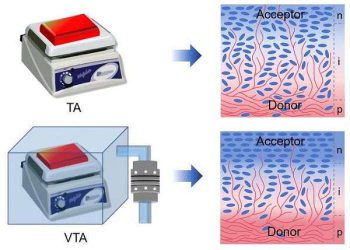by Riko Seibo
Tokyo, Japan (SPX) Nov 12, 2025
Researchers at CSIR-National Physical Laboratory and IIT Madras have fabricated MoS2-coated GaN nanorods on tungsten foil to improve the photoelectrochemical efficiency of water splitting. Gallium nitride nanorods, valued for electron mobility and stability, face limitations from their wide bandgap restricting solar absorption. To address this, the team integrated molybdenum disulfide – a catalytic material – onto the nanorods.
MoS2/GaN nanorods demonstrated a photocurrent density of about 172 microamperes per square centimeter, outperforming bare GaN nanorods by a factor of 2.5. This improvement was linked to Type II band alignment, which enhances charge separation, decreases charge transfer resistance, and increases active sites.
The heterostructures were developed using atmospheric pressure chemical vapor deposition and laser molecular beam epitaxy. Materials analysis using Raman spectroscopy, X-ray diffraction, and X-ray photoelectron spectroscopy confirmed hexagonal phases and mapped electronic states.
These findings suggest that MoS2 integration with GaN nanorods provides a pathway to advance solar-driven hydrogen production technology. The project received support from CSIR-FIRST and SAMMARTH. Future work will focus on scaling the approach for industrial application.
Research Report:Tailoring GaN nanorods with MoS2 on tungsten foil for enhanced photoelectrochemical performance
Related Links
Shanghai Jiao Tong University Journal Center
All About Solar Energy at SolarDaily.com
















